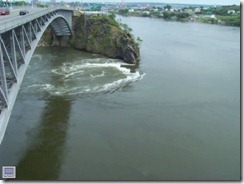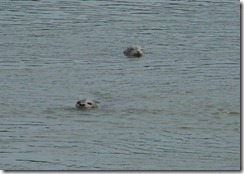 We have moved north from Maine into New Brunswick, Canada. Our border crossing was fairly uneventful. There were no other vehicles at the crossing throughout the short period of time we were there. The Canadian Customs Officer could have charged us some duty based on some of the things we are carrying, but declined to do so upon hearing our story of full timing and figuring that everything was for our personal consumption and not for commerce. Thanks!
We have moved north from Maine into New Brunswick, Canada. Our border crossing was fairly uneventful. There were no other vehicles at the crossing throughout the short period of time we were there. The Canadian Customs Officer could have charged us some duty based on some of the things we are carrying, but declined to do so upon hearing our story of full timing and figuring that everything was for our personal consumption and not for commerce. Thanks!
 Our first stop was at the seaport city of St John on the Bay of Fundy. The bay is famous for the height of its tides The bay is basically a “box canyon”. As I have read, it seems there are three factor at work here that make for the highest tides in the world. First, it seems that within the tidal flows of the oceans, there is a very strong flow that comes off the Indian Ocean, around the Horn of Africa, and straight up the Atlantic toward the Bay of Fundy. The Bay itself narrows and the sea floor in the bay is v-shaped. Finally, the push and pull of the sun and moon are particularly strong in this area. All of these factors combine to create a tremendous swell of water into the bay that has nowhere to go but up and out wherever it can. The low to high tide change can be over 50 feet in parts of the bay. In Saint John, we were seeing about 20 to 25 feet of tide change (compared with maybe 3 to 5 that we saw in Myrtle Beach). But with this much tidal force, the ocean pushes in through the mouths of rivers and actually pushes the water back. The St John River is the major river of New Brunswick, draining more territory by far than any other river in the Province. But even with this mass of fresh water moving out to sea, the tidal forces are so great that the ocean pushes the river back upstream.
Our first stop was at the seaport city of St John on the Bay of Fundy. The bay is famous for the height of its tides The bay is basically a “box canyon”. As I have read, it seems there are three factor at work here that make for the highest tides in the world. First, it seems that within the tidal flows of the oceans, there is a very strong flow that comes off the Indian Ocean, around the Horn of Africa, and straight up the Atlantic toward the Bay of Fundy. The Bay itself narrows and the sea floor in the bay is v-shaped. Finally, the push and pull of the sun and moon are particularly strong in this area. All of these factors combine to create a tremendous swell of water into the bay that has nowhere to go but up and out wherever it can. The low to high tide change can be over 50 feet in parts of the bay. In Saint John, we were seeing about 20 to 25 feet of tide change (compared with maybe 3 to 5 that we saw in Myrtle Beach). But with this much tidal force, the ocean pushes in through the mouths of rivers and actually pushes the water back. The St John River is the major river of New Brunswick, draining more territory by far than any other river in the Province. But even with this mass of fresh water moving out to sea, the tidal forces are so great that the ocean pushes the river back upstream.
In St John, there is an area of the river where there were once waterfalls in ancient times. Today, there are just some rapids. At low tide the water flows through these rapids downstream and out to the ocean. But at high tide, the water is flowing upstream creating rapids going the other way up the river. The water wasn’t just barely flowing upstream, it was roaring upstream. The level of the river is affected as far as 80 miles upstream. Between the high and low tides, there are slack tides during which the river is basically at a standstill.
 As the sea water rolled back upstream, we saw some seals in the river. They were cuties playing out there.
As the sea water rolled back upstream, we saw some seals in the river. They were cuties playing out there.
We truly felt we were watching one of the true phenomenons of nature! And if we figure how to post a video, our report will be even more impressive.
No comments:
Post a Comment